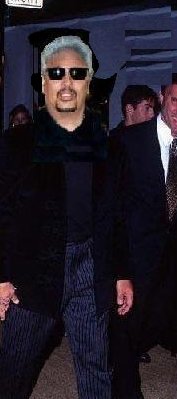EDITOR'S NOTE: This partial interview by Review-Journal columnist John L. Smith with retired FBI undercover agent and author Bob Hamerere http://www.lvrj.com/living/38776657.html . . Listen play first aired in its entirety Jan. 21 on KNPR-FM, 88.9 "KNPR's State of Nevada." A recording of the interview is available online at knpr.org.
JOHN L. SMITH: Thanks to television cop shows and movies such as "Donnie Brasco," the public has an image of the undercover investigator that borders on caricature. Hard-drinking, wisecracking, two-fisted and ready to shoot first and then start the interrogation
Hamer was a U.S. Marine and an attorney when he joined the FBI back before it was known as an agency that specialized in undercover operations. He soon found his niche and began working against some of the darkest forces in the American underbelly: the Mafia, violent street gangs, international money laundering rings and the North American Man/Boy Love Association.
Hamer has hammered them all, winning new convictions and carving out a career that is the subject of his new book, "The Last Undercover: The True Story of An FBI Agent's Dangerous Dance With Evil."
BOB HAMER: I was an attorney. I reluctantly say that. I spent four years in the Marine Corps. I went on active duty in the Marines after graduating law school, and I think I really saw myself after law school as being this high-powered trial attorney that was fighting crime and corruption at every turn.
I got into the Marine Corps, had 150 trials, everything ranging from unauthorized absence to murder, and really did not find any excitement at all in being an attorney. It didn't grab me. Probably for one I wasn't really as good as I thought I was. But every case came down to whether the confession was admissible, whether the case was legal. There were never any whodunits. (Hamer found a new home in the FBI as an undercover agent.)
SMITH: How did you get there and what did you find so fascinating about it?
HAMER: It is actually kind of a limited field even within the FBI. There are currently about 12,700 special agents in the FBI, and maybe only a couple hundred that are what they call certified FBI undercover agents, those that have been selected, have attended the school and have undergone all the psychological screening and then are dubbed undercover agents. So, you're right, it's a pretty limited field. I got into it well before they had all of the screening process. I'm not sure now if I went into it now I could even pass it. But back when I first started. I actually joined the Bureau in 1979, went through the four-month academy, and then reported to the San Diego office in 1980.
Within about six months I was already undercover. Now it requires several years of actual experience as a street agent before you can even apply to the undercover program. So I was there at a time you essentially raised your hand and said 'Yeah, I'll try this.' ... I think it just seemed like the excitement that I was looking for that I didn't find in the courtroom. And trust me after that very first undercover meeting that I had, that adrenaline rush was, I'm assuming, since I'm not a drug addict, that it's the equivalent of the heroin rush that people talk about. I mean I was chasing that adrenaline dragon the rest of my career. I loved it. I loved that rush. I loved that idea of going face to face with the bad guys, of convincing him that you are who you say you are and that you're playing this role. I really relished it. Very early in my career I got hooked on that and continued it throughout my career.
SMITH: Let's talk about one of those early stops. This is where our paths cross at some level.
I wrote a book called "The Animal in Hollywood" about a very tough guy in the L.A. mob, Anthony Fiato, and his experience both as a criminal and as a cooperating witness. You worked in the middle of his world. ... Can you talk a little bit about working La Cosa Nostra in those days in Los Angeles. L.A. is a very big place, but the mobsters weren't too hard to find, I assume, they were just hard to catch.
HAMER: The difference between L.A. and a lot of cities is we didn't have a Little Italy. L.A. had Little Tokyo, they sort of have a Little Saigon. There are a lot of different ethnic communities there, but the Italian family wasn't maybe as strong as maybe they were in other major cities. And as you well know they were sometimes dubbed as the Mickey Mouse Mafia. But they had some pretty significant key players that were involved. They reported to the Commission. They were legitimate La Cosa Nostra, Mafia guys as most of us refer to them. And Anthony Fiato was a major player in that whole organized crime scene.
I worked it both from a case agent perspective, when we were actually targeting Fiato, sat in on hours and hours of wiretaps when we were actually listening to his conversations. And then eventually, when we put together a pretty significant case, he decided to cooperate with the FBI and it was he and his brother Larry who actually introduced me into the L.A. Mafia family.
read full story here
http://www.lvrj.com/living/38776657.html . .
Listen play 




